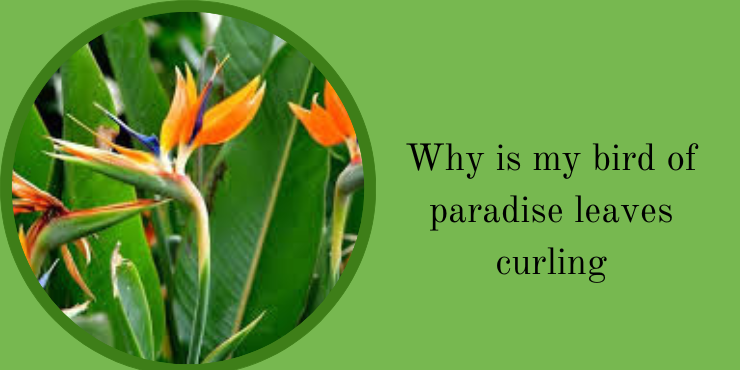Why is my bird of paradise leaves curling
The Bird of Paradise plant, with its striking foliage reminiscent of a tropical paradise, is a favorite among plant enthusiasts. However, the frustration sets in when those lush, broad leaves start to curl unexpectedly. If you’ve found yourself wondering, “Why are my Bird of Paradise leaves curling?” you’re not alone. In this article, we’ll delve into the potential reasons behind this perplexing behavior and explore ways to restore your plant to its vibrant, uncurled glory.
- Natural Leaf Movement:One of the first things to understand is that some degree of leaf movement is entirely normal for Bird of Paradise plants. These plants exhibit a phenomenon known as nyctinasty, where the leaves adjust their position in response to changes in light and darkness. This natural movement might involve slight curling, especially during the evening. Before jumping to conclusions, observe your plant’s behavior throughout the day and night to differentiate between normal leaf movement and a potential issue.
- Watering Woes:Overwatering or underwatering can both lead to leaf problems, including curling. Bird of Paradise plants prefer well-draining soil, and waterlogged roots can result in various issues, including leaf curling. On the flip side, if the plant is not receiving adequate water, it may respond by curling its leaves to minimize water loss. Check the moisture level in the soil and adjust your watering routine accordingly.
- Humidity Levels:Bird of Paradise plants thrive in humid environments, resembling the tropical conditions of their native habitat. Low humidity levels can cause the plant to respond by curling its leaves. Consider increasing humidity around the plant, especially during the winter when indoor heating can reduce moisture in the air. Grouping plants, using a humidifier, or placing a tray of water near the plant can help maintain optimal humidity levels.
- Lighting Conditions:Insufficient or excessive light can also be a culprit behind curling leaves. Bird of Paradise plants prefer bright, indirect light. If placed in low light conditions, they may curl their leaves to maximize light absorption. On the other hand, too much direct sunlight can lead to leaf scorching, prompting the plant to curl its leaves as a protective measure. Find a balance by providing bright, filtered light to keep your Bird of Paradise happy.
- Pests and Diseases:Insects and diseases can stress the plant, causing it to respond with curled leaves. Check for pests such as spider mites, aphids, or scale insects. Treat any infestations promptly using insecticidal soap or neem oil. Additionally, ensure good air circulation around the plant to prevent fungal issues that could contribute to leaf curling.
Cuse by solution my bird of paradise leaves curling

If you’ve noticed your Bird of Paradise leaves curling, it’s essential to identify the underlying issue and implement the appropriate solutions to restore your plant’s health. Here are some common problems and their corresponding solutions:
- Check Watering Practices:
- Issue: Overwatering or underwatering can lead to leaf curling.
- Solution: Ensure that you are following a consistent watering schedule. Allow the top inch of soil to dry out before watering, and make sure the plant is in well-draining soil. Adjust the frequency of watering based on the plant’s specific needs and environmental conditions.
- Evaluate Humidity Levels:
- Issue: Low humidity can cause Bird of Paradise leaves to curl.
- Solution: Increase humidity around the plant by misting its leaves, placing a tray of water nearby, or using a humidifier. This is especially important during the winter months when indoor heating can reduce moisture levels.
- Assess Lighting Conditions:
- Issue: Inadequate or excessive light can result in leaf curling.
- Solution: Ensure your Bird of Paradise is placed in bright, indirect light. Avoid direct sunlight, as this can lead to leaf scorching. If the plant is not receiving enough light, consider moving it to a location with better illumination.
- Inspect for Pests:
- Issue: Insect infestations, such as spider mites or aphids, can stress the plant and cause curling leaves.
- Solution: Check the plant regularly for pests, paying close attention to the undersides of leaves. If pests are present, treat the plant with insecticidal soap or neem oil. Isolate the affected plant to prevent the infestation from spreading to other plants.
- Review Soil Quality:
- Issue: Poor soil quality or compacted soil can affect root health and lead to leaf problems.
- Solution: Ensure that the Bird of Paradise is planted in well-draining soil. Consider repotting if the soil is compacted or if the plant has outgrown its current container. Use a balanced, slow-release fertilizer during the growing season to provide essential nutrients.
- Monitor Temperature Fluctuations:
- Issue: Sudden temperature changes can stress the plant and result in leaf curling.
- Solution: Avoid placing the Bird of Paradise near drafts, air conditioning vents, or heaters. Maintain a consistent room temperature to create a stable environment for the plant.
- Be Patient:
- Note: In some cases, newly unfurling leaves may exhibit temporary curling as part of their natural growth process. Allow time for the leaves to mature and unfurl completely before becoming concerned.
By addressing these potential issues and implementing these solutions, you can help your Bird of Paradise regain its vitality, promoting healthy leaf growth and maintaining the plant’s overall well-being.
Conclusion:
Understanding the reasons behind your Bird of Paradise’s curled leaves is the first step towards nursing your plant back to health. By observing its behavior, adjusting watering routines, optimizing lighting conditions, and addressing potential pest issues, you can create an environment where your Bird of Paradise thrives. Remember, a healthy and happy plant will reward you with its stunning, uncurled foliage, transporting you to the tropical paradise you envisioned when you first brought it home.


